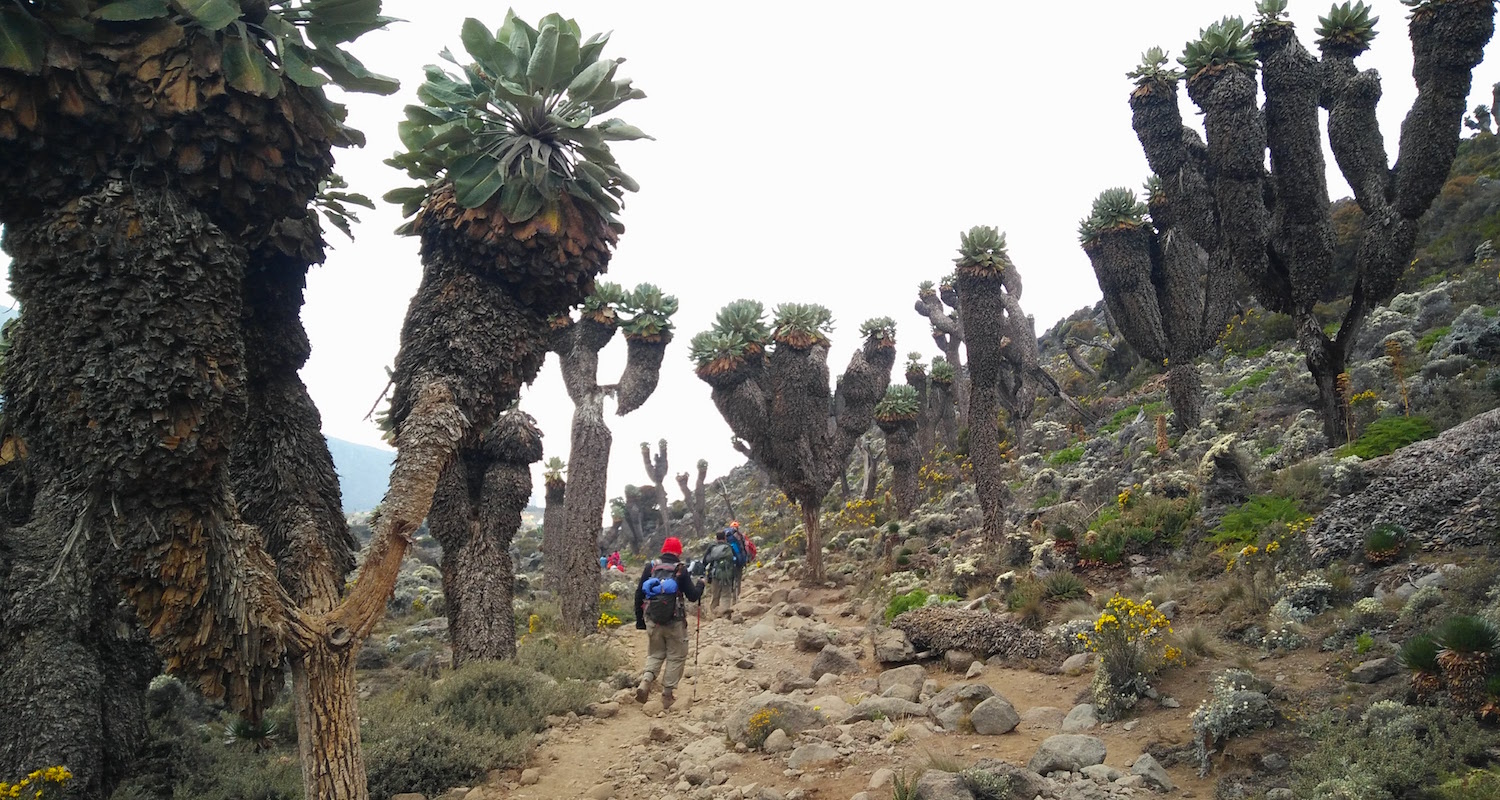We descended a crooked trail from Lava Tower. Nearly 3,000 feet of elevation would be lost in the next few miles. "Hike high; Sleep low," I repeated in a sarcastic voice to no one in particular. The principle was easy enough for the the mind to grasp but painful for the soul. Knowing that this lost elevation had to be regained was disheartening.
We descended from Lava Tower. The trail stretched over the horizon. Photo by teammember Nico Rogers.
The path from Lava Tower dropped to the West Breach. There, we aimed to intercept the flow of hikers following more popular trails. The relative isolation that we had enjoyed the last two days had been lovely. I hated to see it end.
The other unsettling thought was the obstacle beyond our next camp. The Barranco Wall is a vertical challenge facing every Kilimanjaro trekker. It has a reputation. I toyed with the thought for a while, then put it away. Live in the moment. Don't borrow tomorrow's troubles.
Modified image from Google Earth.
Dropping into a protected valley it became obvious that we were no longer alone. Giants began to arise. Initially, they appeared as squatty figures with bad haircuts. Then they rallied in number and arrayed themselves on both sides of the trail. As we neared Barranco Camp, they sprouted limbs as bulbous and as muscled as the forearms of Popeye the Sailor-Man!
Squatty plants with bad haircuts populated the valley.
The serious-minded Godfrey provided answers. The giants were Dendrosenecio kilimajari or giant groundsel. Oddly enough, the tree-groundsel is classed into the same botanical family as the daisy (Asteraceae).* As one stands six inches and the other stands sixteen feet tall, the family resemblance is not obvious!
One explorer suggested that the giant groundsel looks like "a cross between a burned up cactus and a pineapple."** In my case (and you may rightfully blame Saturday cartoons of the 1970s for this) I was pretty sure I remembered seeing them on the set of either H.R. Pufnstuf or Land of the Lost.
The oddities of the giant tree-groundsel are many. It does not shed its dead leaves, but accumulates them as a winter parka, and (are you ready for this?) in some varieties the fresh leaves contain anti-freeze slime! At night, these leaves close around its tender little buds and protect them from the cold!
The giants sprouted bulbous forearms like Popeye the Sailor-Man!
The Dendrosenecio kilimajari is a miraculous mutant. Populations are only found in the alpine zones of ten mountain groups in East Africa. The tree-groundsel morphs from mountain group to mountain group (e.g., Kilimanjaro, Meru, Kenya) and even exhibits differences from elevation to elevation within a single mountain group! This exercise in adaptability is fascinating, especially when one considers that the tree-groundsel uses the wind as a propagation tool, distributing its seeds only a dozen or so feet. How did this remarkable plant cover the uninhabitable distances (from a grounsel's point of view!) between these cloud-islands in the African sky?
As I marveled at the giant groundsel, we rounded a corner and Barranco Camp came into view. It was a pixilation of bright colors on small plateau. The oranges, greens, and blues of nylon fluttered in the breeze. Beyond the camp loomed the Barranco Wall. We all stopped to stare.
It was fun-loving Maro who spoke first. He breathed one word: "Amsterdam."
Barranco Camp came into view. The Barranco Wall rises beyond.
*Other members of the family are the aster, dandelion, and the sunflower. The family is one of the largest on the planet and takes its name from the Greek ἀστήρ (astḗr) meaning "star." This is descriptive of the star-like shape of the flower-head when viewed from above.
**Find the quote in the post here.
I love Africa but my regular summer work is in Israel-Palestine. If you are a pastor, church leader, or educator who is interested in leading a trip to the lands of the Bible, let me hear from you. I partner with faith-based groups to craft and deliver academic experiences. Leaders receive the same perks that other agencies offer, at competitive prices, and without the self-serving interests that often derail pilgrim priorities.






